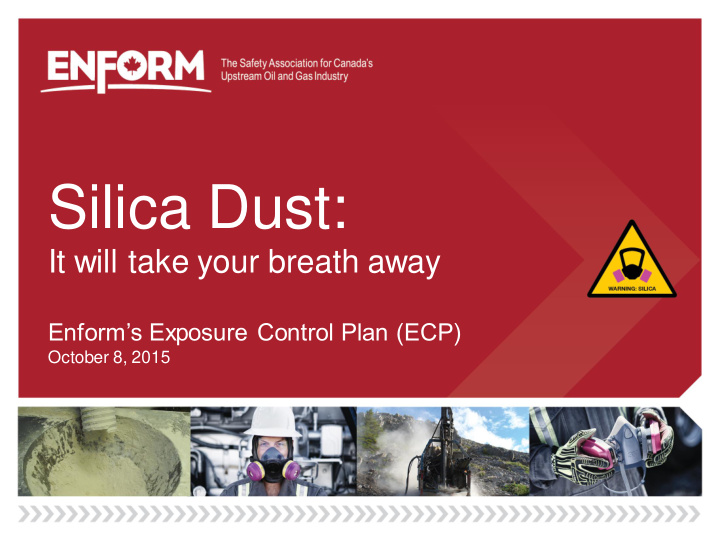



Silica Dust: It will take your breath away Enform’s Exposure Control Plan (ECP) October 8, 2015
Outline • What is silica? • Why should I care? • Exposure risk • Exposure control • Enform’s approach • Questions? 2
What is silica • Silica is naturally occurring and can be found everywhere (SiO 2 ) • Silica can be crystalline (quartz) or non-crystalline (amorphous) • Crystalline silica can be found in: – Rock – Sand – Products like cement, etc. 3 Photo: Wikipedia, http://upload.wikimedia.org/wikipedia/commons/1/14/Quartz%2C_Tibet.jpg
Why should I care? • Silica is a hazard (primarily chronic) when it is breathed deep into the lungs (respirable) • Silica causes the following illnesses: – Silicosis - lung scar tissue – Lung cancer – Bronchitis – Kidney disease • Irreversible and progressive 4
Exposure risk • Silica’s OEL 0.025 mg/m 3 2 X 8-hour OEL – 8-hour TWA (respirable fraction) – What does that mean? – 2X lower than lead (0.05 mg/m3) – 400X lower than nuisance dust (10 mg/m3) – If it’s silica and it’s visible, overexposure is just a matter of time! 5
Exposure risk • How do we re-think our perceptions of risk? 6 Photo Courtesy of NIOSH
Exposure risk • You may be thinking that I am exposed for only a few days, weeks or months, I will be ok, right? • A worker at 100X the Silica OEL – With no respirator they get a working lifetime in 90 days • Even at 100X, acute health effects may not provide adequate warning • After 100X, risks are likely not linear, – i.e. high exposures for even short periods have more risk 7
Where could I be exposed? Frack Seismic Drilling Proppant Air-hammer Drilling Mud Handling and Drilling Additives Storage 8 Photos courtesy of a Industry company, NIOSH and OSHA
Fracking - Exposure Sources • Proppant (sand: 30-99% quartz) – The high percentage of quartz and amount of energy imparted into the sand makes this hazard unique – Any transfer points • Rail to truck • Truck to sand tent or site sand storage (vertical or horizontal) • Site sand storage to hopper • Pneumatic in-loading on site – Working in visible frack dust? 9
Drilling - Exposure Sources • Handling and adding drilling mud dry-product additives – Barites, Graphite, etc… – If it’s naturally sourced, be suspicious • Cement In-loading – Portland cement verses additives • Cuttings Dryers – Most of cuttings are rock = silica • Shaker Mist Photo: Eelgin Industries – Rock dust and fluid additives 10
Seismic - Exposure Sources • Main source is hard rock such as sandstone, granite and shale – Depends on shot hole parameters • Depth and diameter of hole – Wet or Dry Environment • Up on hill or next to river 11
Other Sources • Refractory brick removal - furnaces* • Construction - road and lease • Abrasive blasting - sand substitutes* • Cement handling • Cutting, grinding, and drilling concrete 12
Controls - Engineering • The answer to many silica exposures is engineering and administrative controls – This does not have to be expensive/difficult • Wet materials • Distance/time etc. • Look for opportunities to make a difference! – Take some action (action = caring) 13
Controls - PPE • Different dust levels = different protection levels – Respirator protection factors • Half-face - 10 • Full-face - 50 and 100 • PAPR or Supply Air - 1,000 – Why? Leakage, where the respirator meets the face – Coveralls 14
So what do I need to do? • Fracking – Depends on the presence of engineering controls and where you are working – What is needed? • Consistently applied engineering controls 15 Photo: Industrial Vacuum Equipment Corp.
So what do I need to do? • Fracking – Some workers need a ½ mask • Not in dust on an on-going basis • At least 3 meters from source – Some workers need full-face or better • On-going and close to source • Handling frack dust (powders) – Adjacent workers may be at risk • If you are breathing visible frack dust you need a respirator (micro-seismic, flow back, medics etc.) 16 Photo: NIOSH
So what do I need to do? • Drilling - Dry-Product Additive Handling – Use engineering ventilation controls • Direct exhaust ventilation into mud tanks – Add product slowly - one bag per minute • Reduces dust generation (energy) • Ensures complete incorporation into drilling fluid – Wear a respirator (minimum half mask) – Keep your distance from cement in-loading and use a dust capture bag on exhaust – Follow Invert exposure control plan 17
So what do I need to do? • Air-hammer Drilling – Engineering controls • Venturi • Vacuum • Water injection • Blower fan – Stay upwind of dust when ever possible – Use respirator • No engineering controls? You may need a full-face respirator 18 Photo: Sun Machinery Corp.
Enform’s Approach • Silica ECP template – Modular approach • Guidance Sheets – Sources – Controls – Hazard Assessment 19
What Now? • Silica ECP and Guidance sheets (frack) available at enform.ca • Worker tools and resources are being completed • The CCH Guideline update for release later this year • Pick up the Fall issue of Frontline 20
Summary • Silica is not nuisance dust! • Silica is everywhere • What you don’t know will still hurt you • Enform’s Controlling Chemical Hazards Guideline has the answers you need • Solutions by industry - for industry 21
Is your worker’s future clear? Silicosis Lung Healthy Lung Photo: https://www.pinterest.com/pin/262968065712044291/ and Wikipedia, http://commons.wikimedia.org/wiki/File:8.- 22 _Miner%27s_lung_with_silicosis_and_tuberculosis.jpg
Questions Contact: Robert Waterhouse Email: robert.waterhouse@enform.ca 23
Recommend
More recommend